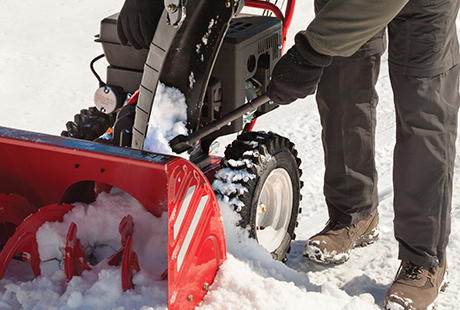One of the most common injuries to people handling snowblowers is damage to their fingertips. This leads to amputation. As such, preventing these injuries should be your top priority. Grievances occur mostly when the snow is wet, heavy or has accumulated several inches. The snow blocks the exit chute of the machine and this makes the user use their hands to unclog it. However, even if the machine is off the blades can still rotate cutting anything and everything in their path.
If you are going to use a snow blower this winter to clear snow around your home, it is key to be aware of all the safety precautions you need in order to avoid injury or worse:
Before You Begin
Before you begin working on clearing your snow you should have a thorough routine check of your blower before use. This ensures it is not clogged and forcing you to put your hands into its blades.
Secondly, safety rules for the use of a snow blower require keeping the machine in proper repair. This involves ensuring the machine has a substantial amount of oil and that all of its tires are inflated.
For electric snowblowers, it is in your best interest to make sure that the cord is not damaged or frayed.
General Snow Blower Safety Tips
- If it is the first time for you to handle a snow blower it is important that you read through the user’s manual thoroughly. Also, for those who have used it continuously, this is not a bad place to start especially if you switched to a different model. There may be some safety instructions pertaining to specific models.
- The snow blower shields are an important safety feature and should always be kept in place.
- Users should always avoid reaching into moving parts with their hands. If the machine is clogged use a broom or stick after you have shut down the machine.
- To avoid carbon monoxide poisoning avoid starting the machine in an enclosed space. Always step outside before starting your snow blower.
- Snow blowers pick up almost anything including rocks and other objects. Always check the direction of the discharge chute to ensure your safety and for those around you.
How to Avoid Clogging Your Snowblower
- Work fast but work smart. The faster the blades spin the less likely you will have any snow sticking and causing a clog.
- If the forecast predicts heavy and wet snow, you should consider using your snowblower during snowfall.
- People have also shared that spraying the blades and chute with cooking oil helps to avoid clogging.
What If Your Snowblower Clogs?
- The first and most important step is to always shut it off.
- Secondly, disengage the clutch.
- Wait a while as the impeller blades stop rotating.
- Do not use your hands to try to unclog your snowblower chute or blades. Remember they may still rotate even after shutdown. Use a stick or broom to handle the clogged areas.
- Never remove the shields and keep your hands and feet away from any moving parts.
Safety should always come first when dealing with any heavy machinery. Be it your gas powered or electric powered snowblower ensure you follow all the right steps to ensure both your safety and for those around you.



